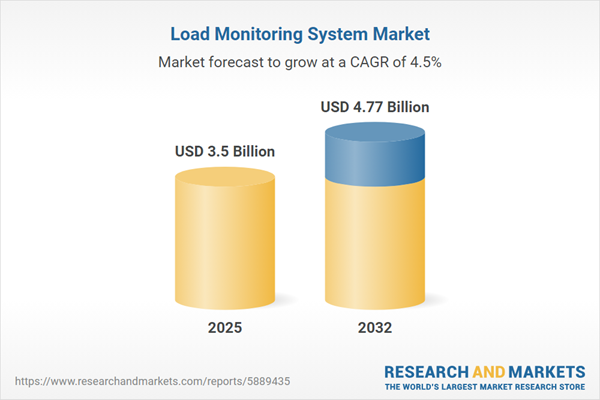Speak directly to the analyst to clarify any post sales queries you may have.
The load monitoring system market is evolving for organizations seeking greater energy efficiency, regulatory compliance, and operational agility in complex settings. Executives now prioritize integrated digital strategies to gain real-time insight, streamline processes, and strengthen resource management.
Market Snapshot: Load Monitoring System Market Overview
The global load monitoring system market was valued at USD 3.35 billion in 2024 and is expected to reach USD 3.50 billion by 2025, representing a 4.5% compound annual growth rate. This positive outlook is supported by widespread adoption of real-time monitoring capabilities and investments aimed at enhancing operational reliability. Organizations across diverse sectors seek advanced energy management frameworks to enable accurate forecasting, increase asset efficiency, and mitigate operational risk. Accelerated adoption further supports agile planning and enables a transition to data-driven workflows, giving decision-makers the capacity to adapt in a changing environment.
Scope & Segmentation of the Load Monitoring System Market
- End Users: Commercial organizations—such as in education, healthcare, and retail—derive benefits alongside a broad range of industrial sectors, including manufacturing and extraction. Residential developers and utility providers also use load monitoring solutions to fulfill compliance standards and ensure project objectives are met for both small- and large-scale deployments.
- Application Areas: Solutions target demand response, predictive maintenance, diagnostic assessment, energy management, automated fault detection, and peak load management. Adoption in these areas delivers robust infrastructure stability and enables optimal use of assets in complex operations.
- Monitoring Types: Organizations can apply scheduled evaluations, leverage AI-powered analytics, integrate predictive rule-based systems, or deploy continuous live tracking. These methodologies are selected to align with distinct compliance goals or evolving efficiency requirements.
- Deployment Models: Cloud-based models offer scalability, hybrid approaches utilize edge computing for localized intelligence, while on-premises deployments provide direct organizational control for strict security or regulatory contexts.
- Technology Platforms: Wired systems utilize technologies such as Ethernet and power line communication, whereas wireless options—including LoRaWAN, Wi-Fi, and Zigbee—support flexible infrastructure and enable easier upgrades for dynamic environments.
- Regional Coverage: The market is shaped by adoption dynamics in North America, South America, regions within EMEA, and Asia-Pacific. Each region’s unique policy frameworks and infrastructure maturity impact vendor selection and influence timelines for project implementation.
- Competitive Coverage: Major industry players include Schneider Electric SE, Siemens AG, ABB Ltd, General Electric Company, Eaton Corporation plc, Honeywell International Inc., Emerson Electric Co., Rockwell Automation, Yokogawa Electric Corporation, and Mitsubishi Electric Corporation. Their participation guides standards for benchmarking and informs strategies for partner selection.
Key Takeaways for Senior Decision-Makers
- Implementing IoT, edge computing, and analytics equips teams to respond promptly to regulatory or market shifts, helping preserve business continuity without significant workflow disruptions.
- Embedding load monitoring within compliance processes enhances transparency and reliability, which supports stronger stakeholder confidence and lays the groundwork for sustainability objectives.
- Leveraging predictive maintenance and diagnostic tools helps minimize operational interruptions, delivers more reliable asset performance, and extends equipment lifecycle across facilities.
- Modern load monitoring bridges operational and IT domains securely, simplifying data flows and supporting strategic planning as infrastructure evolves or expands.
- Applying digital twin technology and machine learning speeds up detection and resolution of anomalies, driving better infrastructure outcomes and continuous system improvement.
- Adapting implementation to regional infrastructure or regulatory frameworks strengthens an organization’s competitive positioning across local and global markets.
Tariff Impact: Adjusting Supply Chains and Competitive Tactics
Recent changes in U.S. tariffs have led manufacturers to update sourcing strategies and bolster supply chain resilience at the regional level. Adopting modular system architectures and collaborating more closely with regulatory agencies allows companies to address evolving operational risks and maintain stable competitive positioning as global trade landscapes and compliance duties change.
Methodology & Data Sources
This report draws on insights from senior executive interviews, comprehensive sector research, and critical review of technical documents. Every interpretation and data point is validated by industry subject matter experts to ensure objectivity and reliable reporting.
Why This Load Monitoring System Market Report Matters
- Enables leaders to identify market drivers and proactively address risks, supporting informed decisions within energy and load management sectors.
- Clarifies the operational impacts of regulatory changes and energy trends, helping organizations prepare for solution adoption and business process transformation.
- Offers actionable insights and benchmarking to optimize procurement and support sustainable enterprise growth amid increasing market competition.
Conclusion
Integrated load monitoring systems remain fundamental to achieving resilient infrastructure and efficient operations. This report provides senior teams with key insights to guide procurement, enhance performance, and drive strategic growth in today’s dynamic landscape.
Additional Product Information:
- Purchase of this report includes 1 year online access with quarterly updates.
- This report can be updated on request. Please contact our Customer Experience team using the Ask a Question widget on our website.
Table of Contents
3. Executive Summary
4. Market Overview
7. Cumulative Impact of Artificial Intelligence 2025
Companies Mentioned
The companies profiled in this Load Monitoring System market report include:- Schneider Electric SE
- Siemens AG
- ABB Ltd
- General Electric Company
- Eaton Corporation plc
- Honeywell International Inc.
- Emerson Electric Co.
- Rockwell Automation, Inc.
- Yokogawa Electric Corporation
- Mitsubishi Electric Corporation
Table Information
| Report Attribute | Details |
|---|---|
| No. of Pages | 181 |
| Published | October 2025 |
| Forecast Period | 2025 - 2032 |
| Estimated Market Value ( USD | $ 3.5 Billion |
| Forecasted Market Value ( USD | $ 4.77 Billion |
| Compound Annual Growth Rate | 4.5% |
| Regions Covered | Global |
| No. of Companies Mentioned | 11 |









